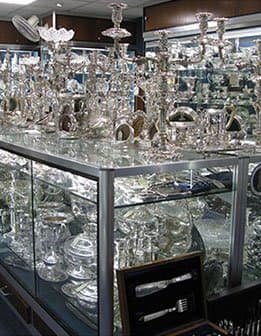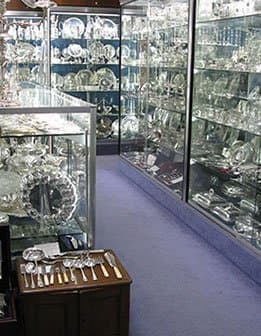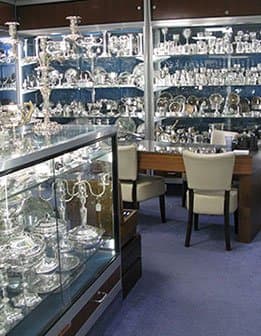Silver is a precious metal with a very unique set of characteristics.
Silver has both high sentimental value and manufacturing/industrial value, much more so than gold, platinum and palladium.
The price of silver per troy ounce in 2020 varied between £21.70 and £10.28 with an average of £18.20. The average price has risen by +£5.17 (+40.63%).
Of course, whilst the intrinsic value of pure elemental silver is important when valuing any silver item or object, if you’re looking for a valuation on antique silver, then there are many other factors involved than the price of silver alone.
Is Silver a Safe-Haven Investment?
Silver is considered a ‘safe-haven’ investment. That means that it retains its value well when ‘paper money’ or fiat currency is in a state of considerable fluctuation or decline (e.g. recession).
However, silver’s price and value are influenced by its industrial uses and it is, therefore, more volatile than gold. Silver is used widely in industries such as the energy industry, medical industry and electronics industry.
The supply and demand economics of these industries influences silver’s price considerably.
The Historical Price of Silver
The price of silver has changed much more in recent years compared to other precious metals owing to its rapidly proliferating industrial uses.
Silver has been considered valuable to some extent for thousands of years. The silver trade was hugely influential across ancient Europe, Asia and the Americas and according to economic historians, it was silver, not gold, that formed the foundations of our modern economy.
Silver’s uses have always been wider-ranging than other precious metals. The modern uses of silver changed dramatically in the 1800s when silver was used in early photographic printing techniques. Through the early 1990s, silver was mined heavily for the medical industry due to its potent antibiotic and healing properties. In 1920s America, over 3 million prescriptions were written out for silver-based products.
The value of silver is closely linked to its industrial uses and their impact on the supply and demand of silver. Due to its diverse uses, the supply and demand for silver is much more variable than gold (where only 15% of its value is created from industrial uses vs 50%+ for silver).
The industrial uses of silver influence its price greatly as demand fluctuates with technological development. This accounts for the volatility of silver vs gold.
The price of silver is still heavily attached to its sentimental value and use in antiques and high-value artisan silverware, though, and this partly helps silver retain its use as a safe-haven investment.
The Economics Of Silver Supply and Demand
The supply and demand market for silver is lively and constantly changing.
Silver’s value will remain high or rise if there is a supply-demand deficit, meaning that there is not enough silver mined/produced to satisfy demand. When new technologies are discovered that utilise silver, e.g. solar panel manufacture, silver becomes more scarce and sought-after, thus increasing its price until supply stabilises.
One example is the 2011 silver spike which saw the value of silver reach a near-historical high. This was largely due to a massive demand surplus for silver for solar panel engineering.
The peak value of silver in 2011 was £29.26 a troy oz. vs £17.91 today, which is still very high vs past averages. It must noted in that in 1979, the price reached £20.00 a troy oz which allow for inflation, equates to £100.00. Historically in the 18th century the price per troy oz, in today’s money was £60.00 to £70.00.
Silver’s price will also depend on mining techniques. Right now, silver is both mined and produced as a by-product of mining and refining other metals such as copper and lead. As mining and production methods for silver become insufficient, its price could also rise as supplying silver becomes a more expensive endeavour.
Silver as an Investment
Silver is still considered a ‘safe-haven’ investment like gold. Its fluctuating price provides a different challenge for investors than gold – it’s certainly possible to make shorter-term trades with silver compared to gold due to more volatile industrial market conditions.
Silver is frequently also used alongside gold as a ‘hedge’ investment. Riskier investments can be hedged against safe-haven investments like precious metals that will likely retain their value.
What About Antique Silver?
The economics of elemental silver is not the same as the economics of antique silver and the value is also not easy to compare.
Most antique silver is not even made from pure silver but sterling silver, an alloy with 92.5% silver and 7.5% copper (and traces of other metals). Another less common high-quality silver alloy is Britannia silver (95.8% pure silver).
Sterling silver and other alloys are used instead of pure silver as they’re much harder than pure silver itself. Pure elemental silver is soft, ductile and malleable and ultimately not ideal for creating practical items that are handled regularly.
The Value of Antique Silver
Silver, by weight, is not a valuable metal when it comes to antiques. Whilst there is scrap value to silverware, the value of antique silver largely emanates from other factors relating to the piece itself, its maker and when it was made. An example would be, a 2 troy oz spoon made in the reign of Henry VIII could be £30,000.00, whereas a 2 troy oz spoon made in the 1790s would be £50.00.
Like any antique, silverware is valued based on what can be identified of the piece. The vast majority of European silverware can be identified from hallmarks, maker’s marks and style. Whilst there is a vast quantity of commercial, mass-made silverware in circulation, there are also some very exclusive pieces with exceptional value.
Prolific examples include silverware crafted by Paul Storr and Mappin and Webb and Hester Bateman.
Valuing Silverware
To value silverware, it must first be positively identified as sterling silver or another similar high-quality silver alloy. Silver-plated items are nowhere near as valuable as genuine sterling silver pieces. It is usually easy to identify silver-plated items as these are brighter and shinier compared to the deeper grey-metal lustre of genuine sterling silver.
Genuine antique sterling silver items made across Europe from around the 1600s/1700s onwards will practically always have some sort of hallmark or maker’s mark.
If a piece has a verified antique origin and is genuine sterling silver then it will have a value. Pieces from prolific makers or with particularly old origins will be worth the most. There is no substitute for a professional valuation – you would be surprised by the value of some unassuming looking silverware.
Our Makers
An A to Z list of silversmiths featured on our website
About Us
If you see something in Archive that you would have liked please contact us as we might be able to source
Our Store
Our store is situated in vaults 3 and 5 on the right-hand side of the main corridor at The London Silver Vaults



